| Reviews & Columns |
|
Reviews DVD TV on DVD Blu-ray 4K UHD International DVDs In Theaters Reviews by Studio Video Games Features Collector Series DVDs Easter Egg Database Interviews DVD Talk Radio Feature Articles Columns Anime Talk DVD Savant Horror DVDs The M.O.D. Squad Art House HD Talk Silent DVD
|
DVD Talk Forum |
|
|
| Resources |
|
DVD Price Search Customer Service #'s RCE Info Links |
|
Columns
|
|
|
Satantango
THE MOVIE:
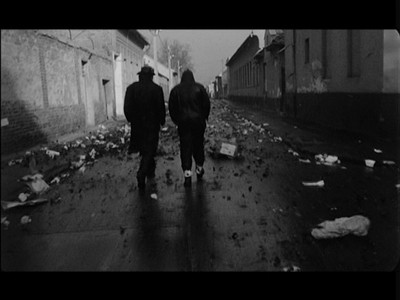
I am almost at a loss as to where to begin to talk about Hungarian director Bela Tarr's 1994 human epic Satantango. Taking two years to film and clocking in at seven hours, Tarr's adaptation of László Krasznahorkai's novel is a masterwork of cinema, managing to maintain the style and scope of a rich prose work while still speaking with the living tongue of film language. The best capsule comparison I can come up with is that it's like Andrei Tarkovsky working from a script by Krzysztof Kieslowski adapting a novel by Leo Tolstoy. If that description at all makes sense to you, and if you like those guys, then this new boxed set of the film is something you must check out. Which isn't to say I wouldn't recommend Satantango to any adventurous filmgoer, as I would do so without hesitation. I just know that the particular gentlemen I referenced are going to strike chords in certain people, and those people are going to be more than ready for Tarr's overwhelmingly immersive cinematic achievement.
Satantango is set in an out-of-the-way, rundown Hungarian village in the 1980s. As with any small town, everyone is involved in everyone else's business. One guy is sleeping with another guy's wife, drunken rivalries erupt at the local watering hole, and as soon as any bit of news hits the area, it spreads faster than crabs in a brothel (and given the kind of prostitutes they have around there, there's probably a lot of that going around, too). The gossip that has everyone talking at this juncture is the return of Irimias (Mihály Vig) and Petrina (Putyi Horvát), two apparently bad dudes who were essentially believed to be dead, or who at the very least were not expected to return any time soon. The timing couldn't be worse for a group of the local peasants. Kraner (János Derzsi) and Schmidt (László Lugossy) were about to bug out of town with their wives and a pile of mysterious money they had been sitting on, leaving the rest of the village in the lurch. Reluctantly, they were also going to take the crippled Futaki (Székely Miklós, star of Tarr's Damnation), who overheard the secret plan while hiding from Schmidt after having almost gotten caught sleeping with Mrs. Schmidt (Éva Almássy Albert). The return of these missing figures has suddenly made this getaway far more dangerous and next to impossible.
There is much left unexplained in Satantango, making the film willfully obtuse in such a way that not only intrigues its viewers by stringing them along with the promise of some answers, but also creates an otherworldly air of mystery. The true story of Irimias and Petrina takes on many permutations, teasing our imagination. Were they in jail? Their encounter with a government official who is conscripting them into public service would have us believe so, though what they are supposed to do in this man's charge is as ambiguous as the actions that put them in this position. What the pair did before they disappeared to make the town fear them is also only communicated in half-heard whispers. Even their return has multiple tellings, including the ongoing ramblings of an alcoholic (István Juhász) who repeats the story over and over, removing and changing details by the minute. The duo appears on the scene as if they were some kind of elemental force, an ill-wind quite literally traveling with them and going on ahead of them to warn of their coming. With the wind also comes nonstop rain, like a Biblical plague is now being visited on the village.
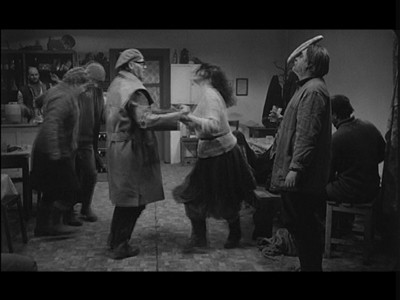
There is actually much that could be seen as religious allegory in Satantango. There are multiple references to the apocalypse, and Irimias speaks like a prophet and also looks a little bit like Jesus. The title itself refers to a long night of drunken dancing amongst the villagers that could be seen as the final act of decadence to bring God's vengeance on them. It's while the adults are drinking themselves stupid that a local girl, Estike (Erika Bók), despondent over her own sins and the neglect that has forced her to such actions, takes rat poison and surrenders herself to the angels. Her mother has left the girl alone all day, forcing her out of the house while she sells her body and then slipping into an alcoholic stupor. In one of Tarr's signature extended takes, the director crafts one of the most disturbing things I have ever seen on film. For several minutes and without any cuts, Tarr shows Estike taking out her anger on her cat, wrestling with and torturing the poor animal before making it the first victim of the rat poison. The brutal realism of the shot sat in my chest like a hard fist, making me hold my own cat close and lament every time I so much as raised my voice to her. I almost had to turn off the movie and take a break at that point, and when I did take my next pause in the viewing, I immediately jumped online to find out if the cat was actually killed. Apparently not, and Tarr claimed that it became his pet when filming wrapped. My public service of the day is warning you of this ahead of time.
Upon Estike's death, Irmias takes charge, using her suicide as a way to guilt the rest of the town into surrendering their cash and following him into the plan he had been slowly drawing together. It's the false prophet in action, calling on his people to follow him into whatever abyss he has planned. Tarr beckons us to follow, as well.

Satantango is told as one grand story circling through the remote village at its center. The narrative is broken into segments of varying lengths that move from one character to the next, sometimes never connecting directly, but often overlapping and doubling-back to show where different chapters criss-cross. Like a Faulknerian mystery, each brushstroke adds to the overall mosaic, elaborating further details. It's the supposed innocent, Estike, who ends up being the true hub of the story, with her solitary journey crossing over the most paths. It's also as she passes away that the intermittent narrator informs us of her internal monologue and her realization that all life is connected. All of these actions feed into the stream of human activity, and Tarr and Krasznahorkai, who also collaborated on Damnation and Werkmeister Harmonies, structure their narrative as a circle. Everything and everyone feeds on itself. Irimias has sent his people to a government-sanctioned purgatory after promising them the freedom of heaven.
Bela Tarr is perhaps most famous for his style. His work is patiently paced, and he is meticulous about capturing the details of life as he assumes they would naturally happen. His camera sometimes lingers for long periods of time, taking in the scenes as unbroken strings of activity, and sometimes moves away from the central figures, exploring the world around them, de-emphasizing their importance in the greater happening that is all existence. In many ways, his camera also serves as an eye of judgment. He often begins a shot at a distance, as if peeping in on people who believe they are acting in secret, before zooming in to reveal that everything that they do is under the gaze of his almighty direction. A great example of this is when Estike and her brother sneak off into the woods to bury a handkerchief full of coins, with the older boy telling his little sister that they will grow into a money tree. At the start, they are small figures in the distance, digging their hole, but by the time they are putting the currency in the ground, Tarr is right there with them, seeing it all. Then, when they exit, he lingers on the disturbed earth, adding to a relentless feeling of dread. We know that the money will not multiply, and we know it will likely be gone when Estike returns to see if it has sprouted, and by leaving us to stare at the scene of the crime, Tarr also forces us to ponder all the many possible outcomes of this con. In the same way, Tarr also lingers on the pain and longing of his characters, moving from their silent faces to the dilapidated nature of their surroundings, the crags on their faces matching the cracks in the walls. Again, if this is purgatory, then it's an endless existence of waiting for something to happen and it never coming.
I know there is a natural tendency for people to flinch when they hear a movie is seven-hours long, but one need not be daunted by Satantango. While the pacing is slow, the narrative is engrossing, and as with many of the best of the glacially paced films, from Antonioni and Malick through the better mumblecore pictures, I find that this type of movie, which so requires your attention, actually passes the time faster than pictures that are fueled on higher-octane edits. If you think about it, most people think nothing of watching DVD season sets of hour-long dramas that are twice as long as this, so why should there be an issue over watching one movie of extended length? Besides, this film is broken into episodic chapters on each disc, as well as into nearly equal thirds over the three DVDs. There is plenty of time for anyone watching at home to pause and pick up the film again as it is convenient. (I watched half-an-hour on a Thursday, just to get a taste, and then watched the rest on the following Sunday.)
To continue the comparison to a novel, Satantango probably takes less time to watch than it is does read a really good book, and it's just as rewarding. Bela Tarr's ode to misguided faith born of desperation is a mesmerizing cinematic event that has come back around all too rarely since its initial release. I urge everyone to take advantage of this opportunity now that its readily available and let this passionate director enfold you in his vision.
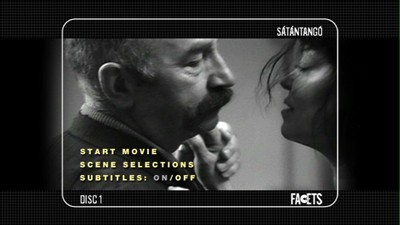
THE DVD
Video:
Satantango was originally shot on 35 mm in a 1.66:1 aspect ratio, and Facets points out on the packaging that bringing the film to DVD required an extensive restoration that was given the approval of Bela Tarr himself. As far as the surface image is concerned, the care is readily apparent, with very little by way of dirt or scratches. A few pops and spots got through, but they are negligible when weighed against the whole.
As we know, however, surface wear is not the only important element in a digital transfer, and though the scrubbing on the picture is commendable, the DVD producers stop short of pushing this one all the way across the goal line intact. The non-anamorphic transfer is consistently plagued by a soft resolution that makes many of the edges on the figures and the background appear hazy. Though I did notice some egregious combing in more active scene, the more evident problem was a faint shimmer in a lot of scenes where Tarr utilized more aggressive panning, and this also manifests as image grain from time to time. Levels of dark and light between individual chapters are hard to judge, but there were a few scenes where there was a perceptible change on screen.
Overall, I did find Satantango to be entirely watchable and not nearly as awful as some other reviews I've read have suggested, but it does seem to be a couple of steps off from where a film of this importance should be. I wouldn't discourage anyone from buying it, nor would I refrain from buying it myself, as I consider it an essential addition to my library. This issue will, however, prevent me from adding it to the upper echelon in the DVD Talk ranking, and some may consider trying to sample the release somehow before taking a full plunge.
Sound:
The soundtrack is a Dolby mix of the original Hungarian monaural recording. This is a fairly average audio mix, without any noticeable problems like the image transfer. It's mainly a quiet movie, with an intermittent score that has an unnatural, over-saturated quality seemingly by design. Despite having no fancy effects, there is a decent atmosphere created by utilizing different volumes to create a spacial relationship between actors in the movie.
The optional English subtitles are fine, but they can move quickly and you might occasionally miss something if you look away. If it sounds like the actors are about to start talking a lot, perk up and stay focused! There are few odd typos, but nothing horrendous.
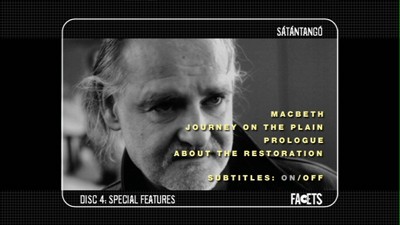
Extras:
The three main discs in the Satantango set have no extras, but a fourth DVD has quite a few. Note right now, though, that the problems seen in the main feature video-wise are also here, and are actually slightly worse.
Of the four featurettes on DVD 4, two are specifically related to Satantango, and both of those are pretty unexciting. The 5-minute "About the Restoration" is an example of specific moments in the movie where the Facets team cleaned up damage to the print, showing the before and after. A 34-minute film from 1995 called Journey on the Plain was made by Bela Tarr, and it shows actor/composer Mihaly Vig (Irmias) revisiting the sets from Satantango, reciting poetry by Sandor Petofi, and playing music from the score. That's it. Just him walking through the sets a year later, now shot in color. It's a total yawn.
The 5-minute short film Prologue is a segment Tarr made for the 2004 anthology movie Visions of Europe. It shows the many faces on a bread line.


Finally, the most interesting extra is a 1982 staging of Macbeth that Bela Tarr shot for Hungarian television. This abbreviated is most notable for being done in two shots: a short intro and then the bulk of the movie, orchestrated to precision by the director.
The DVD set comes packaged in a three-leafed gatefold with plastic trays for each of the main discs. The gatefold book then slides into an outer slipcase. The fourth DVD is in the slipcase inside a square paper sleeve. Also in there is a booklet featuring photos and a symposium of scholars and critics discussing Satantango. Quotes from Tarr also decorate the packaging.
FINAL THOUGHTS:
Yes, my friends, I acknowledge this release of Satantango is severely flawed, and I know for many of you this is a deal-breaker, so save the e-mails and message board posts telling me so. I get it! I, however, feel that Bela Tarr's seven-hour allegory is so worth your time, that it would be worth watching through a pinhole in a brick wall while small children throw walnuts at your head, and for that reason alone, Satantango is Highly Recommended. I know we can be pickier here, but I don't get all bent out of shape if I don't like the font in a printing of Anna Karenina, it's still a fantastic book. While one day we might dream of a better package, for now, this is what we have, and one and all should take the time to immerse themselves in this engrossing epic of human pain and folly.
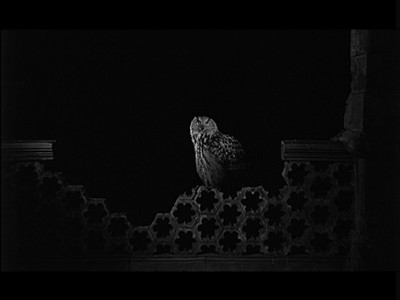
Jamie S. Rich is a novelist and comic book writer. He is best known for his collaborations with Joelle Jones, including the hardboiled crime comic book You Have Killed Me, the challenging romance 12 Reasons Why I Love Her, and the 2007 prose novel Have You Seen the Horizon Lately?, for which Jones did the cover. All three were published by Oni Press. His most recent projects include the futuristic romance A Boy and a Girl with Natalie Nourigat; Archer Coe and the Thousand Natural Shocks, a loopy crime tale drawn by Dan Christensen; and the horror miniseries Madame Frankenstein, a collaboration with Megan Levens. Follow Rich's blog at Confessions123.com.
|
| Popular Reviews |
| Sponsored Links |
|
|
| Sponsored Links |
|
|
| Release List | Reviews | Shop | Newsletter | Forum | DVD Giveaways | Blu-Ray | Advertise |
|
Copyright 2024 DVDTalk.com All Rights Reserved. Legal Info, Privacy Policy, Terms of Use,
Manage Preferences,
Your Privacy Choices | |||||||












